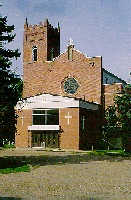

In 1903 the settlers walked or drove on bush and prairie trails to Dead Moose Lake (Marysburg) where a parish was already organized, to celebrate the Sunday liturgy.
Early in 1904, Fr. Dominic Hoffmann, pastor of the newly established St. Ann's Parish, Annaheim, began traveling to Lake Lenore to celebrate the liturgy in the house of Bernard and Agnes Gerwing, the house that stands to this day, having been moved in 1978 to the Lourdes grotto.
Susanna was right. With the promise of regular pastoral visits by Fr. Dominic, the colonists went to the woods in a body on July 4, 1904, to fell logs and by fall their church was built.
The first log church soon had to be enlarged with a sanctuary. A 60 foot high tower was added. The top of this tower was preserved on the John Gerwing farm after the church was dismantled in 1922, and now stands beside the Bernard and Agnes Gerwing home, next to the Lourdes grotto.
By 1919 the young parish had already grown to 500 and a new church was needed. The new pastor, Fr. Bernard Schaeffler, succeeded Fr. Dominic in 1918 but came to Lake Lenore to reside, only in 1922.
He immediately proposed a new church and a school and rectory to complete the parish plant. He dispatched John Gerwing to Detroit Lakes, Minn., to get the blueprint of their church, the handsome edifice we have to this day. At the dedication, Dec. 8, 1922, Fr. Dominic preached and Abbot Michael Ott congratulated the parishioners, remarking, "The churches of St. Peter's Colony must be counted among the most beautiful in all Western Canada."
Since 1995 was the 800th anniversary of St. Anthony's birth the parish marked it in two ways: his statue was brought back to a place of prominence in the church and 10 posters depicting his life in art and in text were put on display in the church hall. One of the posters noted that one important title of Anthony is "protector of the coon".
What are the strong points of St. Anthony's Parish now that it is 92 years old?
First, probably, would be the beauty of the parish church. And not only the building but its furnishings and decoration. There is a simplicity, a proportion and a harmony to all its parts that is seldom reached in an edifice. The Lourdes grotto and the heritage house and church tower are second only to the church in their power to attract.
The pipe organ and congregation al singing are also a strong plus. There is hope that the newly reorganized choir will add one more dimension to the parish's music.
Lake Lenore's setting is also an attractive part of the community. To the west the land slopes downward for two kilometers and then begins gently to rise. So splendid is the view at various times of the day and through all seasons that it has been named "Bright Valley."
To the north is the lake studded with islands' a blue jewel in the green landscape of summer. To the east and south is the lush farmland for which Lake Lenore is noted.
The willingness of many men to pitch in on scaffolding, on bulldozers or with plain hammer and saw, and the readiness with which the women work for the parish (their quilts and meals at the annual bazaar are justly famous) is another important plus.
The abbacy history book is being published just seven years short of the 100th birthday of St. Peter's Colony. T.S. Eliot wrote, "a people without a history is forever unredeemable."
Therefore we read in Deuteronomy 4:9: "Tell your children! Do not forget the things your eyes have seen, nor let them slip from your heart all the days of your life: rather tell them to your children and your children's children."
![]()
[ Home ]
[ The Humboldt Journal ][Early Humboldt]
[ St. Peter's Abbey | Agriculture | Communities ]
[ Present-day Humboldt and Surrounding Communities ]
[ Language ]
![]()
Please send comments to Carlton Trail REDA Inc.